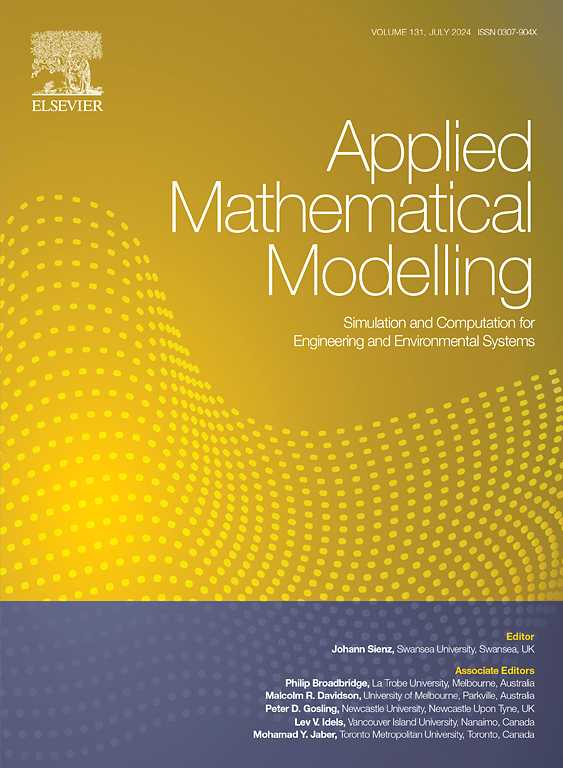A heterogeneous continuum traffic flow model considering mixed connected and autonomous vehicles
IF 4.4
2区 工程技术
Q1 ENGINEERING, MULTIDISCIPLINARY
引用次数: 0
Abstract
Under the background of mixed scenarios of Connected and Autonomous Vehicles and Connected and Autonomous Electric Vehicles, a novel mixed car-following model considering the information of multiple vehicles and the difference of safety spacing in different driving scenarios is proposed. Then, the corresponding heterogeneous continuum traffic flow model is derived. Secondly, through the linear and nonlinear analysis approaches, the linear stability condition and the KdV-Burgers equation are yielded to describe the characteristics of traffic flow evolution. Finally, numerical simulations are performed to explore the density evolution of traffic flow under different initial density and permeability conditions. The conclusions can be summarized as follows: (1) The derived model can well simulate spatiotemporal phase changes and traffic flow phenomena such as stop-and-go waves and local cluster effects. (2) With the increase of the permeability of electric vehicles and speed difference sensitivity coefficient, the road density decreases from 0.15veh/m to 0.06veh/m, the traffic congestion area decreases, and the traffic congestion is effectively suppressed, which also verifies the rationality of the above theory.
考虑到混合互联和自动驾驶车辆的异构连续交通流模型
在 "互联与自动驾驶汽车 "和 "互联与自动驾驶电动汽车 "混合场景背景下,提出了一种考虑多车信息和不同驾驶场景下安全间距差异的新型混合跟车模型。然后,推导出相应的异构连续交通流模型。其次,通过线性和非线性分析方法,得出线性稳定条件和 KdV-Burgers 方程,以描述交通流的演变特征。最后,通过数值模拟探讨了不同初始密度和渗透率条件下交通流的密度演化。结论可归纳如下:(1)推导出的模型可以很好地模拟时空相变和交通流现象,如走走停停波和局部集群效应。(2)随着电动汽车渗透率和速度差敏感系数的增加,道路密度从 0.15veh/m 下降到 0.06veh/m,交通拥堵面积减小,交通拥堵得到有效抑制,这也验证了上述理论的合理性。
本文章由计算机程序翻译,如有差异,请以英文原文为准。
求助全文
约1分钟内获得全文
求助全文
来源期刊

Applied Mathematical Modelling
数学-工程:综合
CiteScore
9.80
自引率
8.00%
发文量
508
审稿时长
43 days
期刊介绍:
Applied Mathematical Modelling focuses on research related to the mathematical modelling of engineering and environmental processes, manufacturing, and industrial systems. A significant emerging area of research activity involves multiphysics processes, and contributions in this area are particularly encouraged.
This influential publication covers a wide spectrum of subjects including heat transfer, fluid mechanics, CFD, and transport phenomena; solid mechanics and mechanics of metals; electromagnets and MHD; reliability modelling and system optimization; finite volume, finite element, and boundary element procedures; modelling of inventory, industrial, manufacturing and logistics systems for viable decision making; civil engineering systems and structures; mineral and energy resources; relevant software engineering issues associated with CAD and CAE; and materials and metallurgical engineering.
Applied Mathematical Modelling is primarily interested in papers developing increased insights into real-world problems through novel mathematical modelling, novel applications or a combination of these. Papers employing existing numerical techniques must demonstrate sufficient novelty in the solution of practical problems. Papers on fuzzy logic in decision-making or purely financial mathematics are normally not considered. Research on fractional differential equations, bifurcation, and numerical methods needs to include practical examples. Population dynamics must solve realistic scenarios. Papers in the area of logistics and business modelling should demonstrate meaningful managerial insight. Submissions with no real-world application will not be considered.
 求助内容:
求助内容: 应助结果提醒方式:
应助结果提醒方式:


